North America Warehouse Automation Market Size
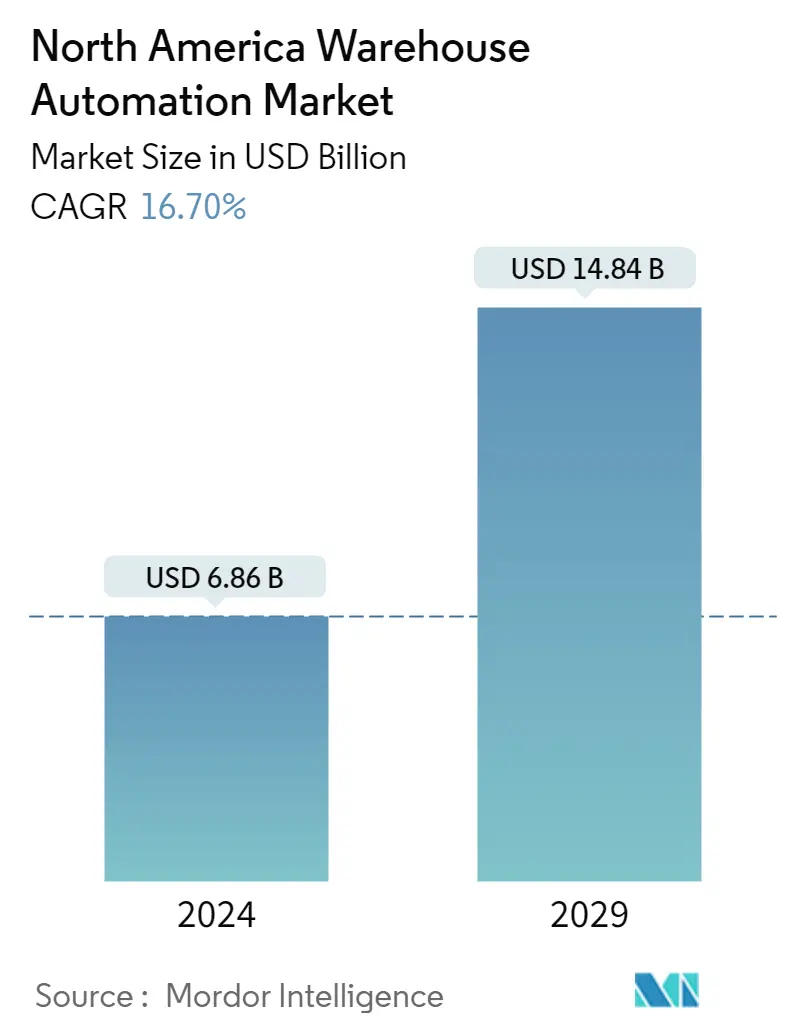
| Study Period | 2019 - 2029 |
| Base Year For Estimation | 2023 |
| Market Size (2024) | USD 6.86 Billion |
| Market Size (2029) | USD 14.84 Billion |
| CAGR (2024 - 2029) | 16.70 % |
| Market Concentration | Medium |
Major Players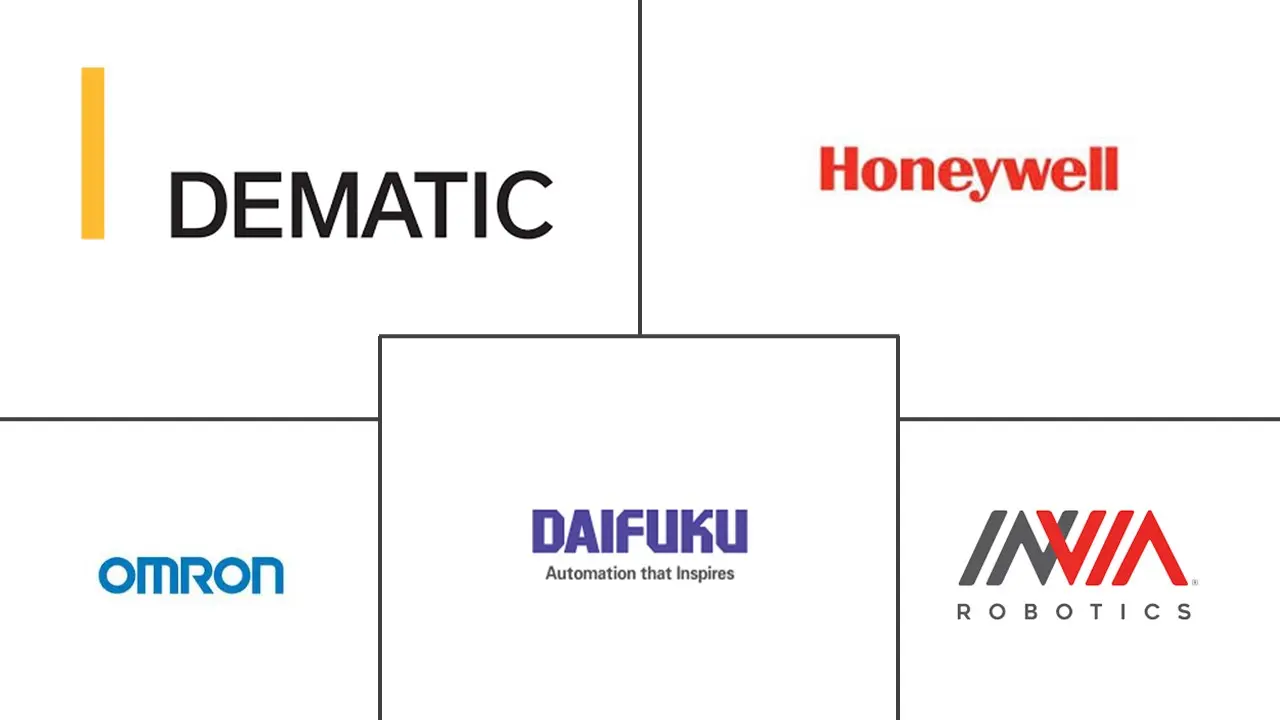
*Disclaimer: Major Players sorted in no particular order |
North America Warehouse Automation Market Analysis
The North America Warehouse Automation Market size is estimated at USD 6.86 billion in 2024, and is expected to reach USD 14.84 billion by 2029, growing at a CAGR of 16.70% during the forecast period (2024-2029).
The use of machines, control systems, and software to increase operational efficiency by using minimal human assistance in the warehouses for inventory movement is known as warehouse automation. The benefits of automating include improved customer service, scalability & speed, organizational management, and error reduction.
- By 2025, according to the Bank of America, 45% of all manufacturing will be carried out using robotic technology. Following this trend, large companies such as Raymond Limited (an Indian textile company) and Foxconn Technology (a China-based supplier to major tech makers like Samsung) have replaced workers by incorporating automatic technology in their factories.
- According to the Generix Group, automation initiatives should start with a well-optimized implementation of the Warehouse Management System (WMS). WMS alone can increase productivity by 20% at ten times the cost of installing a warehouse. Then, depending on the company's needs, there are ways to introduce robotization, for example, by setting up an automatic de-palletizing/palletizing system. The robot picks up a specific package from different palettes and creates its palette.
- Moreover, various factors have directly impacted the increasing adoption of warehouse robotics. The rising number of warehouses and increasing investments in warehouse automation, coupled with the global rise in labor costs and availability of scalable technological solutions, have driven the market for warehouse robots across the region.
- Rapid enhancement in automation technology by market vendors has led to new variations in these product ranges or software functionalities occurring more frequently. This has been causing existing technologies to become outdated quickly, and the need to be changed or upgraded regularly accounts for high costs.
- The COVID-19 pandemic has led warehouse operators to consider accelerating their schedules to adopt automation and robotics. Successful deployments create safer jobs by reducing worker interaction while increasing productivity to meet growing e-commerce demands. With the rise of e-commerce in recent months, thousands of physical stores have closed. However, the pandemic outbreak and the lockdown worldwide have affected the warehousing and industrial activities, especially in countries such as the United States.
North America Warehouse Automation Market Trends
This section covers the major market trends shaping the North America Warehouse Automation Market according to our research experts:
Increased Adoption of Robotics In The Warehouses Is Driving The Market
- A growing number of self-driving machines are shuttling clothing and sports equipment down warehouse aisles, pulling bins of groceries, cosmetics, and industrial parts from high stacks, and handing off goods to workers to help deliver orders faster. Some logistics operators are testing forklifts that can be operated remotely, allowing employers in tight labor markets to draw from a geographically broader pool of workers.
- According to a Ware2Go survey, 67% of Americans work from home. This means they have easy access to online shopping. E-commerce is more dependent than ever as the COVID-19 pandemic has changed how Americans shop. As a result, over half of U.S. companies are increasingly willing to invest in automation to respond to changing market conditions. The 2020 Honeywell Intelligrated Automation Investment study found that the e-commerce grocery(66%), food and beverage (59%), and logistics (55%) industries are most likely to invest more in automation.
- Some players are investing in developing disinfection robots due to the sudden increase In demand during the coronavirus pandemic. For instance, in April 2020, Ocado announced the launch of its first robotic automated warehouse in North America, which the Empire company would use to begin testing orders in Ontario, Canada. It is the second Ocado customer fulfillment center to be opened internationally in 2020.
- The market is also witnessing various partnerships to deploy automated solutions in the logistics sector. For instance, in May 2021, ABB robotics collaborated with Cam Industrial and Remtech Systems to introduce automation solutions for logistics and supply chains in Alberta and British Columbia to address the growing need for flexibility, speed, and accuracy in fulfillment centers based on consumer demand.
- Today's intelligent robots are well suited for the complex demands of omnichannel supply chains. For example, autonomous mobile robots (AMRs) have more agile navigation capabilities that allow them to navigate anywhere in the warehouse using built-in sensors and laser scanners to retrieve goods and deliver them to workers. As the U.S. workforce continues to work inside and outside this new workforce, automation will help businesses maximize these e-commerce opportunities and ensure that society has what it needs to thrive and prosper.
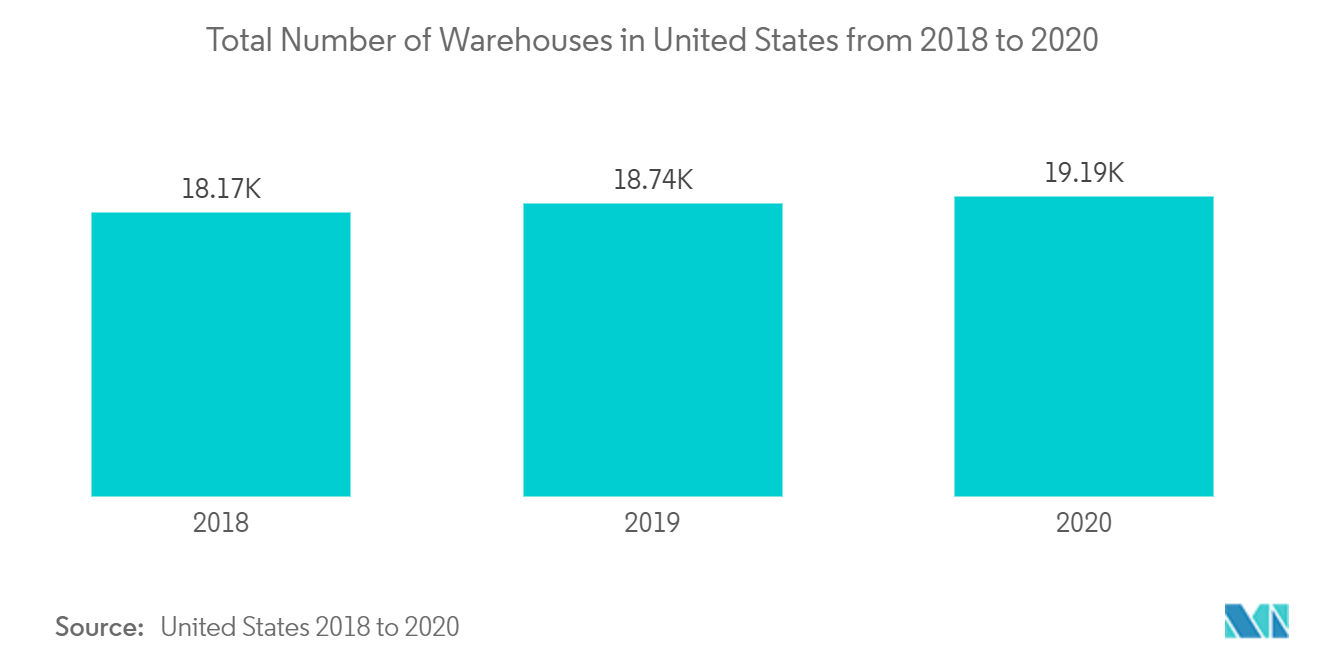
Growth In The E-commerce Industry and SKUs Proliferation.
- With the advent of always-on e-commerce and faster response times, the need to manage large numbers of error-free stock-keeping units (SKUs) are expanding warehouses, fulfillment centers, and intelligent and efficient standards. The urgent need to reduce costs, streamline operations and increase efficiency drives robot innovation. In addition, the economy is growing, and the demand for automation due to intensified competition in the retail e-commerce market in the region is driving the market's growth.
- Technological advances and market changes, such as the rise of omnichannel logistics, have required companies to add new items to their catalogs. Companies may increase the number of SKUs (Stock Keeping Units) sold to expand their customer portfolio. SKU spikes are a strategy aimed at increasing sales by stocking more products, and companies can serve more customers and, as a result, earn more sales.
- In April 2021, 3PL Central, one of the leaders in cloud-based Warehouse Management Systems (WMS), acquired Skubana, a leading inventory management system and e-commerce operations platform. With this acquisition, 3PL Central expanded its supply chain technology offering to include intelligent order routing and inventory management to provide an integrated fulfillment solution from the shopping cart to the warehouse.
- Similarly, in September 2020, Chewy company plans to drive automation of its entire fulfillment network over the next two years through new warehouse locations and remodeling existing facilities. Chewy opened a second automated fulfillment center in the second quarter and a "limited catalog facility" in the third quarter. Also, Chewy opened its first Limited SKU warehouse in the metropolitan area of Kansas City, Missouri, to respond to spikes in volume and avoid rapid transportation costs and split transportation.
- Also, as per the Materials Management & Distribution Report, just-in-time ordering, direct-to-consumer distribution, and shifting retailer-wholesaler relationships reduce the number of large-pallet orders. The growth of small, multiple SKU orders is forcing warehouses to automate. The availability of technology, in such cases, has led to an ease of deployment by decreasing the time and cost of re-designing the whole facility.
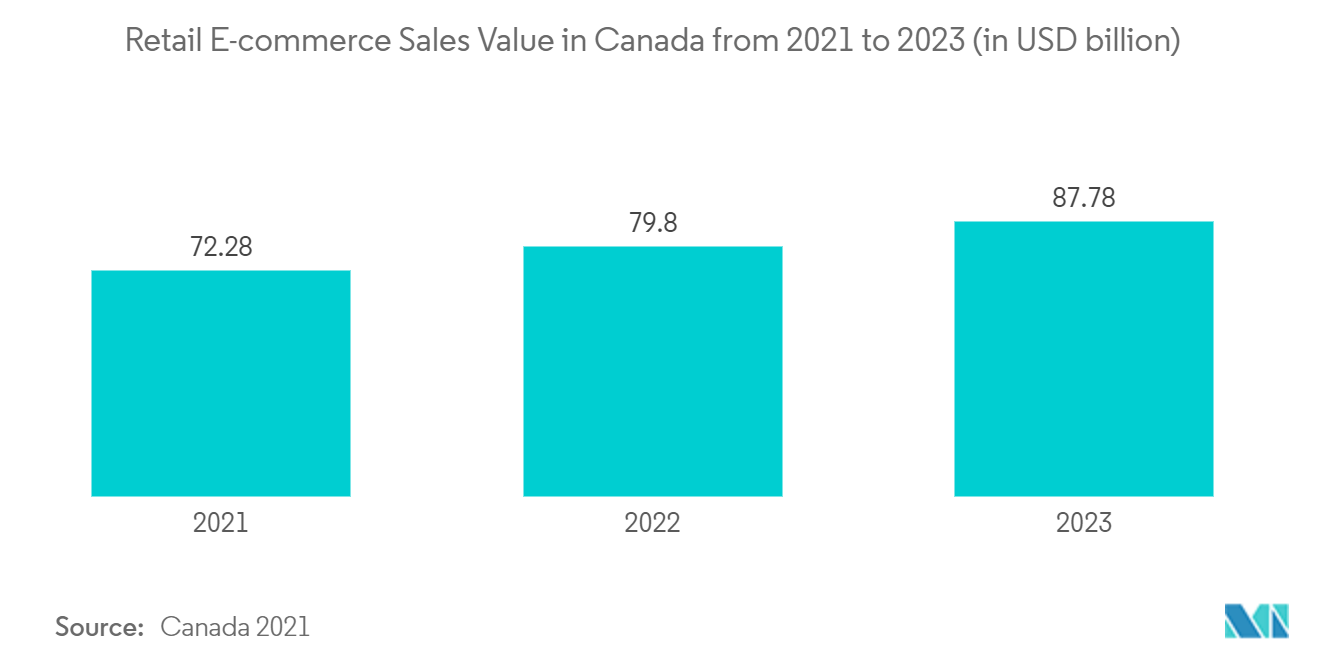
North America Warehouse Automation Industry Overview
The North American warehouse automation market's competitive environment shows the market's fragmentation with major global players, including Dematic Group, Daifuku Co. Limited, Swisslog Holding AG, and Honeywell Intelligrated. Product launches, acquisitions, and partnerships are key strategies market players adopt in the warehousing automation industry.
- June 2021 - Invia Robotics, Inc. announced agreements with more than ten companies currently providing warehouse technology solutions. The contracts are part of a comprehensive channel partner program designed to supplement inVia's direct selling initiatives through new channels. It expands the company's capacity to provide its AI-driven optimization software and autonomous mobile robots to e-commerce fulfillment centers when warehouses are pressured to automate to keep up with the growing demand.
- October 2021 - The ABB Limited's White Paper focuses on robotics and automation in addressing the challenges and opportunities accelerated by COVID-19, such as labor shortages, omnichannel distribution, and e-commerce growth. ABB offered four critical automation solutions that increase the resiliency of logistics operations through flexible automation. Item picking, palletizing, robotic storage and retrieval systems, and sorting.
North America Warehouse Automation Market Leaders
-
Dematic Group
-
Daifuku Co., Ltd.
-
Honeywell Intelligrated (Honeywell International Inc.)
-
Omron Adept Technologies
-
InVia Robotics Inc.
*Disclaimer: Major Players sorted in no particular order
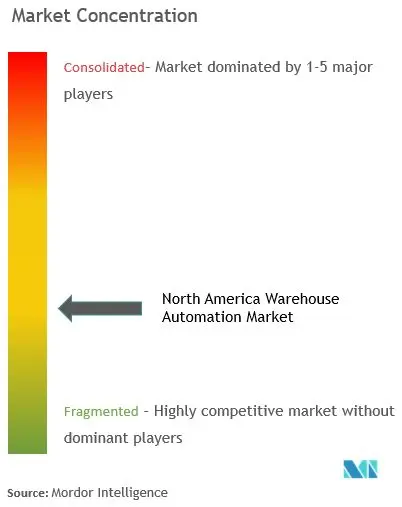
North America Warehouse Automation Market News
- March 2022 - Honeywell announced a strategic partnership with OTTO Motors, a division of Clearpath Robotics, giving warehouses and distribution centers throughout North America an automated option to handle some of the most labor-intensive roles in an increasingly scarce job market. The collaboration enables the company's customers to increase efficiency, reduce errors and improve safety by deploying OTTO's autonomous mobile robots (AMRs) in their facilities.
- March 2022 - Addverb Technologies announced a North American partnership with Numina Group. The agreement expands the deployment of Addverb's innovative mobile robots for automation solutions to North American warehouses. It gives Numina Group customers access to innovative technology applications for faster and smarter warehouse order fulfillment automation.
North America Warehouse Automation Market Report - Table of Contents
1. INTRODUCTION
- 1.1 Study Assumptions and Market Definitions
- 1.2 Scope of the Study
2. RESEARCH METHODOLOGY
3. EXECUTIVE SUMMARY
4. MARKET INSIGHTS
- 4.1 Market Overview
- 4.2 Industry Value Chain Analysis
-
4.3 Industry Attractiveness-Porter's Five Forces Analysis
- 4.3.1 Bargaining Power of Suppliers
- 4.3.2 Bargaining Power of Buyers/Consumers
- 4.3.3 Threat of New Entrants
- 4.3.4 Threat of Substitute Products
- 4.3.5 Intensity of Competitive Rivalry
- 4.4 Impact of Macro-economic Factors on the Warehouse Automation Market
- 4.5 Impact of COVID-19 on the payments market in the country
5. MARKET DYNAMICS
-
5.1 Market Drivers
- 5.1.1 Growth in the e-commerce industry and SKUs proliferation.
- 5.1.2 Increase in technology innovations and availbility
-
5.2 Market Challenges
- 5.2.1 High capital investments for manufacturing products
6. MARKET SEGMENTATION
-
6.1 By Component
- 6.1.1 Hardware
- 6.1.1.1 Mobile Robots (AGV, AMR)
- 6.1.1.2 Automated Storage and Retrieval Systems (AS/RS)
- 6.1.1.3 Automated Conveyor & Sorting Systems
- 6.1.1.4 De-palletizing/Palletizing Systems
- 6.1.1.5 Automatic Identification and Data Collection
- 6.1.1.6 Piece Picking Robots
- 6.1.2 Software (Warehouse Management System, Warehouse Execution System)
- 6.1.3 Services (Value Added Services, Maintenance, etc.)
-
6.2 By End-user Industry
- 6.2.1 Food and Beverage
- 6.2.2 Post and Parcel
- 6.2.3 Groceries
- 6.2.4 General Merchandise
- 6.2.5 Apparel
- 6.2.6 Manufacturing
- 6.2.7 Other End-User Industries
7. COMPETITIVE LANDSCAPE
-
7.1 Company Profiles
- 7.1.1 Dematic Group
- 7.1.2 Daifuku Co., Ltd
- 7.1.3 Honeywell Intelligrated (Honeywell International Inc.)
- 7.1.4 Omron Adept Technologies
- 7.1.5 Invia Robotics Inc
- 7.1.6 KUKA AG
- 7.1.7 Oracle Corporation
- 7.1.8 One Network Enterprises Inc.
- 7.1.9 Locus Robotics
- 7.1.10 Fetch Robotics Inc.
- *List Not Exhaustive
8. INVESTMENT ANALYSIS
9. FUTURE OUTLOOK
** Subject To AvailablityNorth America Warehouse Automation Industry Segmentation
Automated warehouses can be defined as those that provide the following functions: faster order processing, accurate order management, and storage space and capacity. The North America Warehouse Automation Market is segmented by the components of hardware, software, components, and services. Further, the warehouses and fulfillment centers perform activities across end-users, such as food and beverage, post and parcel, apparel, general merchandise, and manufacturing, to name a few. The manufacturing industry majorly includes the automotive, electronics, and pharmaceutical sectors. The study also provides the impact of COVID - 19 on the market and trends of the key players in the region.
| By Component | Hardware | Mobile Robots (AGV, AMR) |
| Automated Storage and Retrieval Systems (AS/RS) | ||
| Automated Conveyor & Sorting Systems | ||
| De-palletizing/Palletizing Systems | ||
| Automatic Identification and Data Collection | ||
| Piece Picking Robots | ||
| By Component | Software (Warehouse Management System, Warehouse Execution System) | |
| Services (Value Added Services, Maintenance, etc.) | ||
| By End-user Industry | Food and Beverage | |
| Post and Parcel | ||
| Groceries | ||
| General Merchandise | ||
| Apparel | ||
| Manufacturing | ||
| Other End-User Industries |
North America Warehouse Automation Market Research FAQs
How big is the North America Warehouse Automation Market?
The North America Warehouse Automation Market size is expected to reach USD 6.86 billion in 2024 and grow at a CAGR of 16.70% to reach USD 14.84 billion by 2029.
What is the current North America Warehouse Automation Market size?
In 2024, the North America Warehouse Automation Market size is expected to reach USD 6.86 billion.
Who are the key players in North America Warehouse Automation Market?
Dematic Group, Daifuku Co., Ltd., Honeywell Intelligrated (Honeywell International Inc.), Omron Adept Technologies and InVia Robotics Inc. are the major companies operating in the North America Warehouse Automation Market.
What years does this North America Warehouse Automation Market cover, and what was the market size in 2023?
In 2023, the North America Warehouse Automation Market size was estimated at USD 5.88 billion. The report covers the North America Warehouse Automation Market historical market size for years: 2019, 2020, 2021, 2022 and 2023. The report also forecasts the North America Warehouse Automation Market size for years: 2024, 2025, 2026, 2027, 2028 and 2029.
North America Warehouse Automation Industry Report
Statistics for the 2024 North America Warehouse Automation market share, size and revenue growth rate, created by Mordor Intelligence™ Industry Reports. North America Warehouse Automation analysis includes a market forecast outlook to 2029 and historical overview. Get a sample of this industry analysis as a free report PDF download.



